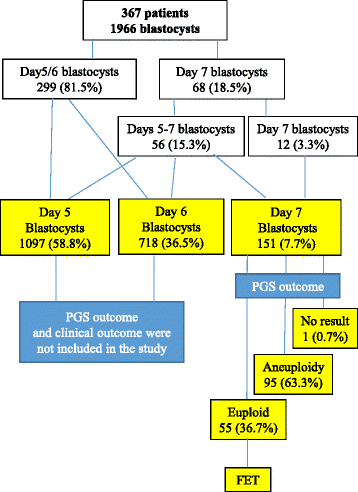Aneuploidy analysis in day 7 human blastocysts produced by in vitro fertilization
- PMID: 27080232
- PMCID: PMC4832487
- DOI: 10.1186/s12958-016-0157-x
Aneuploidy analysis in day 7 human blastocysts produced by in vitro fertilization
Abstract
Background: Human embryos produced by in vitro fertilization (IVF) are usually cultured to day 6 after insemination, and good quality of embryos should develop to blastocyst stage at days 5 and 6. However, some embryos develop slowly, thus they may form blastocysts on day 7. Most IVF laboratories culture embryos to day 6 and then discard retarded embryos that do not develop to blastocyst stage. It has been reported that transfer of day 7 blastocysts can yield pregnancy although the rates were very low. In the present study, we evaluated the prevalence of aneuploidy in day 7 human blastocysts and also assessed embryo implantation after transfer of normal euploid blastocysts developed on day 7.
Methods: Day 7 blastocysts were biopsied and screened for aneuploidy. Embryo implantation was assessed by transferring of euploid blastocysts.
Results: A total of 1966 blastocysts from 367 IVF cycles were biopsied and screened for aneuploidy. It was found that 81.5 % of the patients had days 5 and 6 blastocysts and 18.5 % (68) patients had blastocysts developed on day 7, including 15.3 % had days 5-7 blastocysts and 3.3 % had only day 7 blastocysts. A total of 151 day 7 blastocysts, which accounted for 7.7 % of total blastocysts, were analyzed. It was found that 36.7 % of the blastocysts were euploid and 63.3 % had abnormal chromosomes, including aneuploidy and euploid with partial chromosome deletion. The aneuploidy rate was also maternal age dependent and was as high as 91.7 % in patients who were ≥40 years old. During the study period, transfer of day 7 euploid blastocysts in 15 patients resulted in 2 healthy live births.
Conclusion(s): Aneuploidy rates in day 7 human blastocysts produced by IVF are very high. However, good euploid blastocysts have potential to implant and transfer of day 7 euploid blastocysts can result in healthy live birth. It is suggested that day 7 blastocyst culture may be necessary in patients who need aneuploidy screening.
Keywords: Aneuploidy; Delayed blastocyst; Implantation; PGS.
Figures


Similar articles
-
Correlation between standard blastocyst morphology, euploidy and implantation: an observational study in two centers involving 956 screened blastocysts.Hum Reprod. 2014 Jun;29(6):1173-81. doi: 10.1093/humrep/deu033. Epub 2014 Feb 26. Hum Reprod. 2014. PMID: 24578475
-
What is the reproductive potential of day 7 euploid embryos?Hum Reprod. 2019 Sep 29;34(9):1697-1706. doi: 10.1093/humrep/dez129. Hum Reprod. 2019. PMID: 31398251
-
Worth the wait? Day 7 blastocysts have lower euploidy rates but similar sustained implantation rates as Day 5 and Day 6 blastocysts.Hum Reprod. 2019 Sep 29;34(9):1632-1639. doi: 10.1093/humrep/dez138. Hum Reprod. 2019. PMID: 31402381
-
The cytogenetic constitution of human blastocysts: insights from comprehensive chromosome screening strategies.Hum Reprod Update. 2019 Jan 1;25(1):15-33. doi: 10.1093/humupd/dmy036. Hum Reprod Update. 2019. PMID: 30395265 Review.
-
Is the hypothesis of preimplantation genetic screening (PGS) still supportable? A review.J Ovarian Res. 2017 Mar 27;10(1):21. doi: 10.1186/s13048-017-0318-3. J Ovarian Res. 2017. PMID: 28347334 Free PMC article. Review.
Cited by
-
The slow growing embryo and premature progesterone elevation: compounding factors for embryo-endometrial asynchrony.Hum Reprod. 2017 Feb;32(2):362-367. doi: 10.1093/humrep/dew296. Epub 2016 Dec 16. Hum Reprod. 2017. PMID: 27986817 Free PMC article.
-
Assessing the impact of delayed blastulation using time lapse morphokinetics and preimplantation genetic testing in an IVF patient population.J Assist Reprod Genet. 2019 Aug;36(8):1561-1569. doi: 10.1007/s10815-019-01501-1. Epub 2019 Aug 2. J Assist Reprod Genet. 2019. PMID: 31385120 Free PMC article.
-
Trisomy 21 and Assisted Reproductive Technologies: A review.JBRA Assist Reprod. 2022 Jan 17;26(1):129-141. doi: 10.5935/1518-0557.20210047. JBRA Assist Reprod. 2022. PMID: 34542250 Free PMC article. Review.
-
Association between growth dynamics, morphological parameters, the chromosomal status of the blastocysts, and clinical outcomes in IVF PGS cycles with single embryo transfer.J Assist Reprod Genet. 2017 Aug;34(8):1007-1016. doi: 10.1007/s10815-017-0944-0. Epub 2017 May 30. J Assist Reprod Genet. 2017. PMID: 28560610 Free PMC article.
-
Establishment of day 7 blastocyst freezing criteria using blastocyst diameter for single vitrified-warmed blastocyst transfer from live birth outcomes: a single-center, large cohort, retrospectively matched study.J Assist Reprod Genet. 2020 Sep;37(9):2327-2335. doi: 10.1007/s10815-020-01882-8. Epub 2020 Jul 21. J Assist Reprod Genet. 2020. PMID: 32691193 Free PMC article.
References
-
- Munne S, Lee A, Rosenwaks Z, Grifo J, Cohen J. Diagnosis of major chromosome aneuploidies in human preimplantation embryos. Hum Reprod. 1993;8:2185–91. - PubMed
MeSH terms
LinkOut - more resources
Full Text Sources
Other Literature Sources

